In May 2017 CPOM Leeds hosted the concluding meeting of NERC’s Ice Sheet Stability Research Programme (iSTAR), an effort to improve understanding of West Antarctica’s combined Pine Island Glacier–Amundsen Sea system.
Participants reviewed iSTAR’s combined achievements against the programme’s original objectives: understanding the transport of ocean heat toward the ice sheet, understanding the sub-ice processes affecting ice melt, and understanding the response of the inland glacier to the ocean-induced changes.

An operator prepares an ice-sounding radar during windy weather on Pine Island Glacier. The radar measures ice thickness and detects internal layering within the ice. Credit: David Vaughan
The main messages coming out of the research were:
- Future research in this field should include atmospheric processes, not just ice and ocean processes;
- Long time series observations are critical; and
- More observations are needed of the floating ice sheet before models can reliably predict Pine Island Glacier’s future behavior.
Read the full write-up of the meeting by Andy Smith of the British Antarctic Survey, published in Eos.
